The 1980s – Emergence of a National Multiprogram Institution
by Lynn Yarris
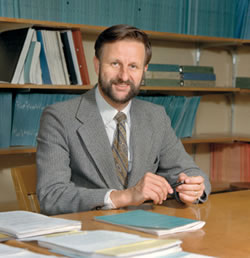
David Shirley, Lab director 1980-89.
For better or worse, the 1980s is probably most remembered as the decade of the “me” generation. It was a time when yuppies — young urban professionals — “shopped till they dropped,” and terms like “hostile takeovers,” “leveraged buyouts,” and “mega-mergers” were added to the public lexicon. “If you’ve got it, flaunt it!” was the clarion call, despite the fact that the decade began with a national economy groaning under the weight of double-digit inflation. In 1981, there came with little fanfare a report from the Center for Disease Control about a mysterious new syndrome that seemed to be attacking the immune systems of gay men. The 1980s saw the 200th anniversary of the U.S. constitution and the birth of MTV. President Ronald Reagan dominated the national political scene, and the 1980 winter Olympics featured a “miracle on ice,” when the U.S.A. hockey team struck gold against all odds.

Yuan Lee, winner of 1986 Nobel Prize in chemistry.
In the world of science and technology, there were headline-making achievements, like the discovery of high temperature superconductors and the launching of the Columbia space shuttle, and headline-making frauds, like cold fusion. More and more people began using personal computers at work and in their homes, and by the end of the decade a medium through which all these new computer users could share information was created, called the World Wide Web. And at the Lawrence Berkeley Laboratory, or LBL as it was widely known, for the first time in the institution’s history a chemist rather than a physicist was chosen to be director.
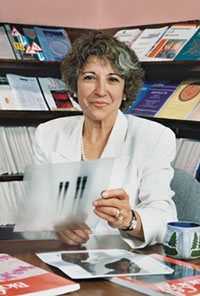
Mina Bissell, author of the ECM theory of breast cancer.
David Shirley was not only the first chemist to direct the Lab, he was also the first director without a background in accelerators. A native of New Hampshire and graduate of the University of Maine, Shirley began working at the Lab in 1958, a year before he got his Ph.D. in chemistry from UC Berkeley. He rose quickly through the ranks as a scientist, winning the prestigious E.O. Lawrence Award in 1972 at the age of 37, for his investigations into the chemical nature of matter. When UC President David Saxon chose him as the successor to Andrew Sessler, he was 45. Shirley took over the directorship just as the Laboratory was plunged into a deep funding crisis. President Reagan’s emphasis on defense R&D spending resulted in substantial financial reductions that forced Shirley to spend his first two years as director trying to manage the worst cutbacks in the Lab’s history. After seeing scientifically solid initiatives rejected because of political considerations, Shirley became savvy enough about Washington to hire Capitol Hill veteran Martha Krebs, who would later become the longest serving head of DOE’s Office of Science. The funding crisis subsided in 1982 thanks to Congressional actions, and Shirley began what would be a decade-long transition. The goal was to take the diversification in research programs begun by Sessler in the 1970s and bring it to full bloom on a nationally recognized level.
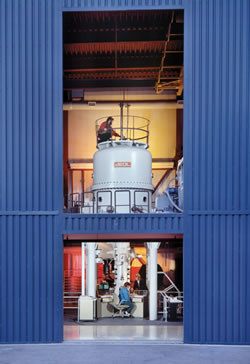
NCEM houses some of the world’s most powerful electron microscopes.
Shirley’s first success came in 1982 when DOE approved an initiative called the Center for Advanced Materials (CAM). Research at CAM was to be tied directly to the most critical needs of U.S. industry, aimed at solving “stopper problems” in materials science that were blocking technological developments. Funding for the CAM initiative helped start construction of the Surface Sciences and Catalysis Laboratory (Bldg. 66) and the Advanced Materials Laboratory (Bldg. 2), the first buildings constructed on the Hill in nearly 20 years. It also helped launch the Center for X-Ray Optics (CXRO), the first research facility aimed exclusively at an expanse of the electromagnetic spectrum stretching from extreme ultraviolet light to soft (low-energy) x-rays called the XUV. Wavelengths of light in the XUV range are ideal for studying and manipulating atoms and molecules at the surfaces of materials, where most chemistry takes place. XUV light is also ideal for studying material properties at nanoscale dimensions.
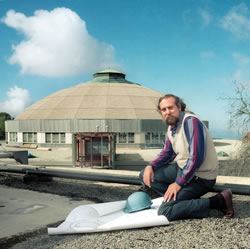
Jay Marx served as project director for the ALS construction.
Spurred by his own scientific interest in the use of XUV light, and his success with the CAM initiative, Shirley, in 1984, put forth the initiative that would become his defining achievement as director. This initiative proposed construction of a new electron synchrotron with a storage ring designed to accommodate special magnetic “insertion devices,” called wigglers and undulators, that would enable it to produce XUV radiation with scientific properties never before attained. The new synchrotron, the first big accelerator to be constructed at Berkeley Lab in nearly three decades, was to be called the Advanced Light Source (ALS).

Section of the ALS booster being loaded into the shielding enclosure.
Shirley and the Lab faced an uphill battle for the ALS. Skeptics called it “Shirley’s Temple” and many in the scientific community questioned the value of a synchrotron optimized for the production of XUV light. But the scientific case for the ALS was fundamentally sound, and Shirley, with help from Krebs and others, was able to procure a recommendation for construction from DOE’s Energy Research Advisory Board to then Secretary of Energy John Herrington. On July 28, 1988, ground for the ALS was broken at the site where Ernest Lawrence’s 184-Inch Synchrocyclotron had stood. The landmark dome that had topped the building which housed Lawrence’s historic accelerator was preserved and refurbished so that it would also top the new ALS building. Construction of the $100 million synchrotron would be led by Jay Marx, a physicist who’d directed the PEP-4 project, one of the largest particle physics experiments of its time.
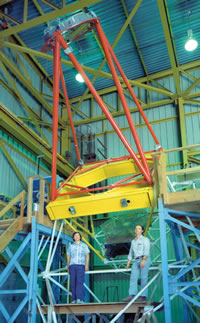
Ten Meter Telescope reference mirror.
Although the ALS would come to symbolize the Shirley directorship, it was but one example of the institutional transitions that took place during the 1980s. On Sept. 30, 1983, the National Center for Electron Microscopy opened for business. Designated as a DOE national user facility, meaning its resources were made available to qualified researchers across the country, NCEM featured two of the world’s most powerful transmission electron microscopes, the million-electron-volt Atomic Resolution Microscope (ARM) and the High Voltage Electron Microscope (HVEM). Earlier that year, the Lab also opened the Center for Computational Seismology, to serve as a national and international source of information on seismic data, and the Neutral Beam Engineering Test Facility, which was to provide a national test bed for the study of neutralized particle beams, used to heat magnetically confined plasmas to the 100-million-degree temperatures needed for controlled fusion.
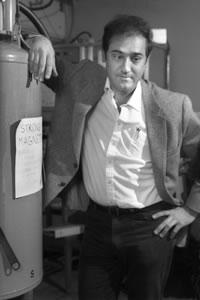
Alex Pines broke new ground in NMR technology.
In addition to providing research facilities that served as national scientific resources, Laboratory scientists also began increasingly directing their own investigations toward problems of nationwide concern. For example, the research begun by John Lawrence to apply accelerator beams to the treatment of cancer and other diseases continued to bear fruit, most notably in the spectacularly successful treatments of ocular melanoma, led by Dr. Joseph Castro and Dr. William Saunders, and arteriovenous malformations (AVMs), inoperable blood clots deep inside the brain, led by Dr. Jacob Fabrikant. However, other Lab researchers also began investigating the causes of cancer. Based on her studies of the behavior of healthy and malignant cells in culture, Lab scientist Mina Bissell proposed that cancer was a multi-step process rather than the result of any one oncogene. She went on to identify a link between breast cancer and the extracellular matrix (ECM), a network of fibrous and globular proteins that surround and support breast cells. Subsequent research revealed how a cell’s micro-environment plays a dynamic role in its growth and development as well as in the onset of malignancies and other diseases. In another significant development, the team of Jack Bartley and Martha Stampfer presented the first experimental evidence linking the environmental pollutant benzo(a)pyrene, a by-product of fossil-fuel burning, to breast cancer.
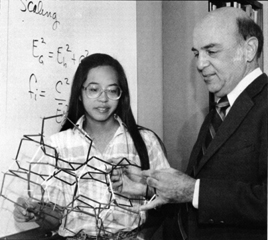
Marvin Cohen and Amy Liu with model of superhard carbon nitride.
Lab researchers further boosted the institution’s reputation in the biological sciences with significant new findings in the study of heart disease and Alzheimer’s disease, and in helping to characterize the role of oxygen radicals in aging and disease. In recognition of the institutional strides made in the biological sciences, the Lab was selected in 1987 as one of two centers for the massive undertaking that was DOE’s Human Genome Project, the national effort to map and sequence the entire complement of human DNA, often referred to as the Holy Grail of biology.
Under Shirley’s watch, the Lab also continued to make a name for itself in environmental studies. Tony Hansen designed a device called an aetholometer that could for the first time make real-time measurements of the vertical distribution of soot particles cast up into the atmosphere by the burning of coal and oil. Hansen’s device was used to reveal layers of soot above the arctic ice cap in concentrations comparable to those found above urban areas. Another team of Lab scientists led by Anthony Nero helped characterize the risks posed to homes by radon, a radioactive Noble gas that can seep into homes from the soil. Still another Lab team identified selenium contamination from irrigation drainage as the reason wild birds were being poisoned to death at the Kesterson Reservoir in the San Joaquin Valley.

The arctic ice cap lies beneath a layer of atmospheric soot as might be found above busy city.
The Lab’s expanding scientific reach was even extending to the stars. The concept of a honeycomb array of 36 hexagonal mirror segments that would act in unison as a single light-collecting telescope mirror measuring 10 meters (400 inches) in diameter, proposed by Lab physicist Jerry Nelson and supported through Director’s Funds, first by Sessler and then by Shirley, was brought to fruition in the early 1980s with the construction and successful testing at the Lab of a prototype segment. Nelson’s dream would be realized in full when, with a multimillion dollar grant from the W. M. Keck Foundation, ground was broken atop Mauna Kea, Hawaii in 1986 for construction of what would be the world’s largest optical and infrared telescope.
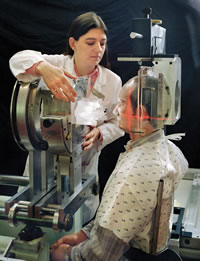
Cancer patients were treated at the Bevalac with the help of a plastic head positioner and beam compensator.
No look back at the Laboratory during the 1980s would be complete without noting the award-winning technological breakthroughs achieved by chemist Alexander Pines in Nuclear Magnetic Resonance, and physicist John Clarke, in the development of SQUIDs — superconducting quantum interference devices; the compressed matter theories of Marvin Cohen that would successfully predict a material, carbon nitride, harder than diamond; and the design and construction of a differential microwave radiometer (DMR), led by physicist George Smoot, for measuring temperature variations in the cosmic background radiation, which was launched aboard NASA’s COBE satellite in the summer of 1989.
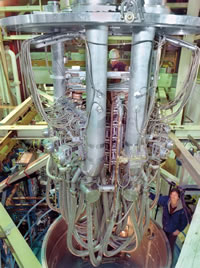
The Neutral Beam Engineering Test facility was used in the development of magnetic confinement systems for fusion energy studies.
But perhaps the most notable of all the scientific achievements at the Lab during the 1980s came on Dec. 10, 1986, when the Royal Swedish Academy of Science announced that Lab chemist Yuan Lee would share that year’s Nobel Prize in chemistry. Lee became the Lab’s ninth Nobel laureate for his development of “crossed molecular beams” to study chemical reactions. In this technique, two beams of selected molecules are accelerated to supersonic speeds then sent on a collision course in a vacuum to create a chemical reaction. When the beams hit, the angles at which the resulting products are scattered and the energy released reveal much about the nature of the reaction. Understanding the hows and whys of chemical reactions has been the driving force in the study of chemistry ever since ancient alchemists tried turning lead into gold.
Shirley stepped down as Lab director on Aug. 31, 1989, with the knowledge that the transition to a national multiprogram institution had been completed. His stewardship, like his appointment to the directorship, had represented a break with Laboratory tradition. The appointment of his successor would represent another break with tradition in that for the first time ever, someone outside of the Laboratory was named to lead it.